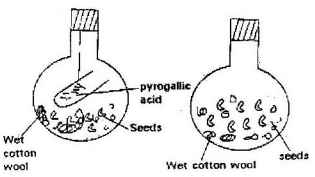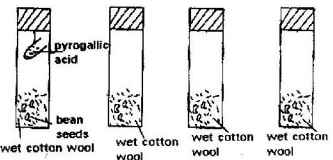Questions
- Explain why several auxiliary buds sprout when a terminal bud in a young tree is removed.
- Account for loss in dry weight of cotyledons in a germinating bean seed.
- What is the effect of gibberellins on shoots of plants?
- A student set up an experiment as shown in the diagram below

The set up was left at room temperature for a week- What was the aim of the experiment?
- What would be the expected results at the end of the experiment?
- State two advantages of metamorphosis to the life of insects
- During germination and early growth, the dry weight of endosperm decreases while that of the embryo increases. Explain
- In an experiment, a group of student set up four glass jars as shown in the diagram below jar A, B and C were maintained at 250C for 7 days. While Jar D was maintained at 00 c for the same period of time.

- What was this set up supposed to investigate?
- Why was pyrogallic acid included in glass jar A?
- Explain why glass jar C and D were included in the experiment
- What result would you expect in glass jar A and B at the end of the experiment?
- State two artificial ways of breaking seed dormancy
- Removal of the apical bud from the shrub is a practice that results in the development of the lateral buds which later from the branches.
- Give reasons for the development of the lateral braches after the removal of the apical bud
- Suggest one application of this practice
- What is the importance of this practice?
- In an experiment some germination seeds were placed in large airtight flask and left for four days
- Suggest the expected changes in the composition of gases in the flask on the fifth day
- Give four reasons for your answer in (a) above
- Name two factors that cause dormancy in seeds
-
- Distinguish between epigeal and hypogeal germination (1 mark)
- Why is oxygen necessary in the germination of seeds? (2 marks)
- An experiment was carried out to investigate the effect of hormones on growth of lateral buds of three pea plants
The shoots were treated as follows:
Shoot A - Apical bud was removed
Shoot B - Apical bud was removed and gibberellic acid placed on the cut shoot
Shoot C - Apical bud was left intact.
The length of the branches developing from the lateral buds were determines at regular intervals
The results obtained are as shown in the table below
Time (days) Length of bbranches in mm Shoot A Shoot B Shoot C 0 3 3 3 2 10 12 3 4 28 48 8 6 50 90 14 8 80 120 20 10 118 152 26 - Using the same axes, draw graphs to show the length of branches against time (8 marks)
-
- What was the length of the branch in shoot B on the 7th day? ( 1 mark)
- What would be the expected length of the branch developing from shoot A on the 11th day? ( 1 mark)
- Account for the results obtained in the experiment ( 6 marks)
- Why was shoot C included in the experiment? ( 1 mark)
- What is the importance of gibberallic acid in agriculture? ( 1 mark)
- State two physiological processes that are brought about by the application of gibberellic acid on plants. ( 2 marks)
-
- State tow environmental conditions that can cause seed dormancy
- Name the part of a bean seed that elongates to bring about epigeal germination (1 mark)
-
- “True growth is not simply an increase in size” State four different ways in which true may be defined.
- State two external factors, which influence growth in plants and describe one effect of each.
- Fill in the spaces in the following table, which refers to hormones involved in growth processes.
Name hormone Site of hormone production Effect Thyroid gland Maturation of Graafin follicles Auxins Gibberellins
- Seedling from 100g of maize seed was grown in the dark for 10 days. The seedlings were then analyzed and compared with 100g of ingeminated maize. The following results were obtained.
Dry mass of ingeminated seeds Dry mass of seedling after 10 days Cellulose
Starch
Other organic
Material Ash2g
63g
13g
2g5g
9g
27g
4gTotal dry mass 80g 45g - Why is dry mass used for comparison?
- How would one ensure that the drying process had been completed
- Account for the decrease in the total dry mass of the seedlings
- Why did the seedling contain more cellulose than the underminated seeds?
- What is the most likely source of the carbon used to form this new cellulose?
Answers
- IAA /auxins produced by terminal bud; inhibits growth of lateral buds, when cut the suppression cease thus auxiliary buds sprouts.
- Food stored is used in (mobilized) up for respiration and growth.
- - They promote cell division
- Promote fruit formation without fertilization/ parthenocarpy. -
- Oxygen is necessary for germination
- Germination in B, no germination in A.
- The adult and larvae exploit different food riches; do not compete for food.
- Endosperm material was converted into new cytoplasm/ the stored food endosperm is used up to the germination seed while the embryo is growing and adding on more protoplasm.
-
- Condition necessary for the germination of seed /to show that water, oxygen and warmth are needed for germination.
- To absorb all oxygen from the jar
- C- to show water is needed for germination of seeds.
- Jar A – seeds would not germinate
Jar B – seeds would has germinated - Scarification i.e. scratching to make impermeable seed coat permeable
- Varnilasation – Cold treatment e.g. species of wheat.
-
- Apical bud produce auxins which inhibits the development of lateral buds.
Removal of terminal buds cause the growth and development and sprouting of lateral buds. - The pruning of coffee/tea.
- More yield /production
- Apical bud produce auxins which inhibits the development of lateral buds.
-
- Low oxygen and increase in CO2
- Germinating seeds respire using O2 and release CO2 only.
- Absence of light, impermeability of seed coat to water, immature embryo, lack of growth hormones presence of inhibitors.
- - Epigeal germination – Epicotyle grows very fast pushing out of soil surface with the cotyleons.
- Hypogeal germination – Epicotyle grows very fast and plumule grows out forming first foliage leaves cotyledons remain underground. -
- Graph
-
- 68 ±1
- 130mm
- Shoot A - Removal of apical bud promotes growth of lateral buds, due to removal of auxins hormones which inhibit lateral bud development.
Shoot B - Gibberellic acid promotes growth of lateral branches
Shoot C - Presence of apical bud inhibit lateral bud development due to reserve of auxins. This is called apical dominance. - As a control experiment to show the effect of hormones (auxins) on lateral bud development.
- - Promotes flowering.
- Promote lateral bud development hence increase yields.
- Break seed dormancy (promote germination) - - Germination
- Flowering
- Activate hydrolytic enzymes
-
- - Absence of water (moisture)
- Unsuitable temperature.
- Lack of oxygen
- Lack of light - Hypocotyls
- - Absence of water (moisture)
-
- - Increase in dry mass
- Increase in cell number
- Irreversible increase in volume of cytoplast
- Increase in differentiation. -
- Light intensity influence rate of photosynthesis.
- Temperature – influence metabolic rate via enzyme action.
- - Increase in dry mass
-
- It indicated the amount of organic material present which is a measure of change in mass cytoplasm.
- Weigh, reheat at 1100C for several hours, and cool constant Mass.
- Most of mass is starch which is converted to sugars and used up in respiration and other metabolic activities.
- Cellulose is synthesized during growth of new cell walls.
- Starch → Glucose → Cellulose
Join our whatsapp group for latest updates
Tap Here to Download for 50/-
Get on WhatsApp for 50/-
Download Growth and Development Questions and Answers - Biology Form 3 Topical Revision.
Tap Here to Download for 50/-
Get on WhatsApp for 50/-
Why download?
- ✔ To read offline at any time.
- ✔ To Print at your convenience
- ✔ Share Easily with Friends / Students

